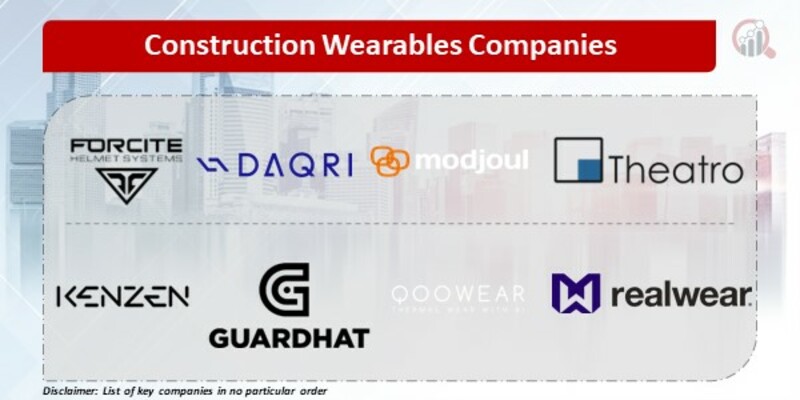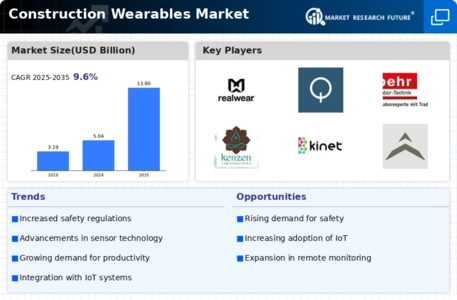Top Industry Leaders in the Construction Wearables Market
 The construction wearables market is experiencing a surge, driven by the need for improved safety, efficiency, and worker well-being on construction sites. As technology advances and adoption increases, understanding the competitive landscape becomes crucial for stakeholders. This analysis dives into the key players, their strategies, market dynamics, and recent developments.
The construction wearables market is experiencing a surge, driven by the need for improved safety, efficiency, and worker well-being on construction sites. As technology advances and adoption increases, understanding the competitive landscape becomes crucial for stakeholders. This analysis dives into the key players, their strategies, market dynamics, and recent developments.
Key Players and Strategies:
-
Established Titans: Honeywell, Bosch, and Hilti leverage their brand recognition and extensive distribution networks to offer a wide range of wearables, from smartwatches for communication to exoskeletons for physical assistance. Honeywell's Forge platform integrates data from various wearables for holistic jobsite insights. -
Tech-Focused Specialists: Companies like RealWear and Trimble specialize in AR/VR smart glasses, enhancing worker training, remote guidance, and data visualization. RealWear's HMT-1 headset overlays digital instructions onto real-world environments, improving worker efficiency. -
Niche Innovators: Smaller players like StrongArm Technologies and IQuarius focus on specific needs, like exoskeletons for heavy lifting or biofeedback sensors for fatigue monitoring. StrongArm's Atlas exoskeleton reduces worker strain and injuries, improving safety and productivity.
Factors Influencing Market Share:
-
Technological Innovation: Offering advanced wearables with features like real-time communication, data analytics, and AI-powered insights sets companies apart. Trimble's HoloLens 2 glasses enable mixed reality collaboration, improving design visualization and communication. -
Compliance and Safety: Wearables that address safety concerns by monitoring vital signs, detecting falls, and enforcing fall protection usage gain traction. Hilti's X-Connect system seamlessly integrates safety wearables with data platforms for comprehensive risk management. -
Integration and Interoperability: Compatibility with existing construction software and platforms promotes data flow and streamlined workflows. Bosch's ExoToolConnect software integrates exoskeleton data with project management tools, optimizing workload assignments. -
Cost-Effectiveness and ROI: Balancing affordability with tangible benefits like improved productivity and reduced costs is crucial for wider adoption. IQuarius' fatigue monitoring sensors provide cost-effective solutions for preventing worker fatigue and associated accidents.
Key Players
- RealWear
- Eleksen
- Retenua
- Qoowear
- Behr Tech
- GuardHat
- Kenzen
- Kinetic
- Theatro
- Strong Arm Technologies
- Reactec
- Modjoul
- SolePower
- Intellinium
- Babaali
- DAQRI
- Forcite Helmet Systems
- Vuzix
- Levitate Technologies, Inc.
- Consigli.
Recent Developments
December 2021: RealWear launched the Navigator 500, the most advanced industrial strength wearable for frontline workers. Because of its clever design, which integrates software, hardware, and cloud-ready services into a robust construction that is one-third lighter and smaller than previous generations, frontline staff will find it easier to wear the RealWear Navigator 500 throughout the entirety of their shift.
December 2020: StrongArm Technologies unveiled FUSE FLEX, its most compact, sophisticated, and durable safety wearable. It offers 360-degree safety and uses tactile, visual, and auditory alerts to continuously monitor ergonomic harm and proximity detection.
February 2023: Ferrovial brought construction sites' first wearable safety devices. Proximity sensors found in coats, helmets, and other accessories attached to the machinery operating on the job site are the basis of their efficient system. When the system senses a risky scenario, it sends out a triple warning that is audible, visual, and physical.

